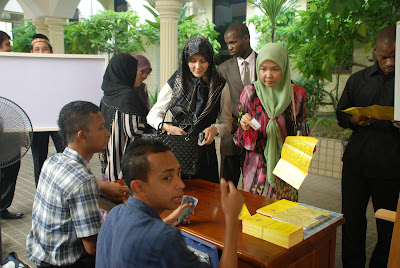Istana Negara:
It was on exactly 20th-July-2012, the Knowledge Management class in support of their noble lecturer Madam Azmawati visited one of the historic places in Malaysia known as Istana Negara. The purpose of this
educational trip was to exploit applicability of Tacit knowledge and
explicit knowledge in which the museum serves as best intervention to apprehend the differences.
The Main Entrance into the Palace
Istana Negara is the official residence of His Majesty, the
Yang di Pertuan Agong, the King of Malaysia and Her Majesty the Queen of Malaysia, Seri Paduka Baginda Raja Permaisuri Agong. It is located on a
hillock at Jalan lstana, just outside the city centre.
The Istana was originally
a double storey mansion built in 1928 by a local Chinese millionaire,
Chan Wing. After the Japanese occupation, it served as a residence of the
Sultan of Selangor until 1957, when the Federal Government indicated interest to use it as the official residence His Majesty, the King of Malaysia after some extensive
renovation.
The visit was very successful as it fulfill the desired objective of explaining the relevance of tacit and explicit knowledge in the domain of knowledge management. The historic events and the use of some royal artifacts were documented through a through conversion of tacit knowledge into an explicit knowledge for the next generation to benefit from. Some of the examples below show how this museum become a knowledge expert in actualizing the KM concept.
 |
| Visitors from MMU |
The guys are anxiously parading into the palace. With all zeal to exhibit and gain more understanding on the concept of KM, more especially on how the operation in SECI model is related to the real life siyuation.
The Father and Mother of the Palace:
 |
| His Majesty |
His majesty the Yang di-Pertuan Agong XIV was born on the 28 November, 1927.
 |
| Her Majesty |
Her Majesty Raja Permaisuri agong Hajah Haminah was born on 15 july, 1953
Below are some Official Royal Regalias
 |
| Muscat |
Muscat: Is the official attire of His Majesty Yang di-Pertuan and of the ceremonial official of Istana Negara. It is made up of black wool embroided with gold thread in the pattern of awam tarat and the habiscus. The malaysian national flowers.
 |
| Pending |
Pending Diraja (Royal Waist): This is a royal waist that is normally worn by his majesty. It is worn on top of the Muscat around the waist.
 | ||
| Tengkolok Diraja |
Tengkolok Diraja (Royal Headdress): Among the recognized Royal headdress in malaysia is Tengkolok. It is made up of silk embroidered fabric folded in various styles. the style folding and color vary from one state to another.
 |
| Kulung Diraja |
Kulung Diraja (Royal Neckless): This is a royal neck-less worn by Her Majesty Raja Permaisuri Agong, Tuanku Hajah Haminah
 | |
| Pendang, Keris Panjang dan Sundang Diraja |
The Sword, Long Keris and Royal Sundang: These are the three traditional Malay weapons originated from the ancient time, which now become part of the Royal Regalia.
 |
| Cokmar |
Cokmar (Maces): Cokmar or Maces are part of the Malaysian Weapon of war in the olden days. It comprises two short shafts with dome-shaped heads made up of silver usually 81.32 cm in length.
 |
| Gending Diraja |
Gending Diraja (Royal Headdress): This is the official headdress of Her Majesty Raja Permaisuri Agong, Tuanku Hajah Haminah.
International, Federal Award of Honours
 |
| International Award |
Knight Grand Cross of the order of the Bath (GCB) United Kingdom 1972. Award Presented to His Marjesty Yang di-Pertuan Agong.
 |
| Federal Award |
Kedah Honorary Award-Diraja Utama Reri Mahawangsa Yang Amar Dihormati (DMK).
 |
| Federal Award |
Kedah Honorary Award-Darja Seri-Setia Sultan Abdul Halim Muazdam Shah Yang. Amat Dihormati (Darja Pertama) (SHMS) Geleran: Dato Seri-Darja
 |
| Federal Award |
Federal Award of Seri Maharaja Mangku (S.M.N), 1958
Official Royal Palace Costumes
His majesty and Her majesty the Seri Paduka Baginda Yang di-Pertuan Agong and Raja Permaisuri Agong are escorted by the Royal Guards to Throne room. All are fully dressed in Royal Regalia.
 |
| Going Back Home |
Finally guys were happily moving back home discussing lot of amazing Malaysian Royal traditions witnessed.
 |
| All Thanks be to Allah (S.W.T) |
More Photos














